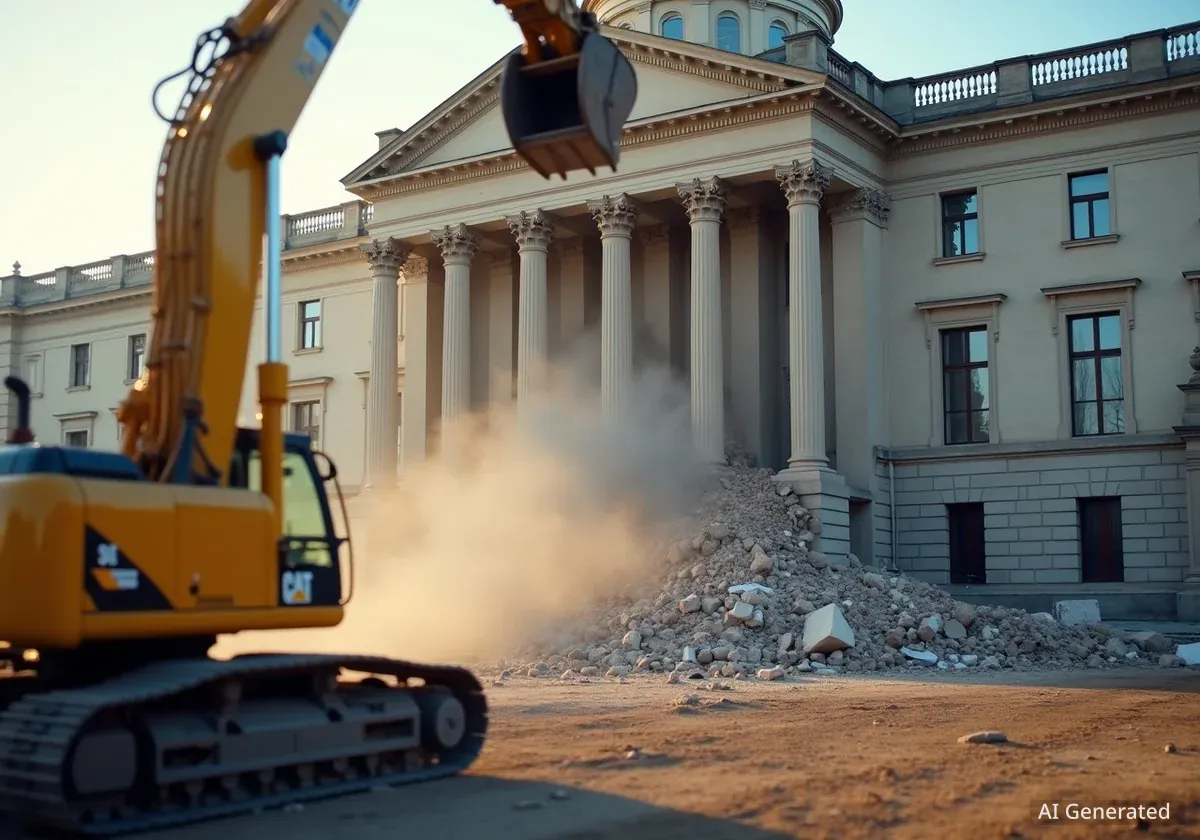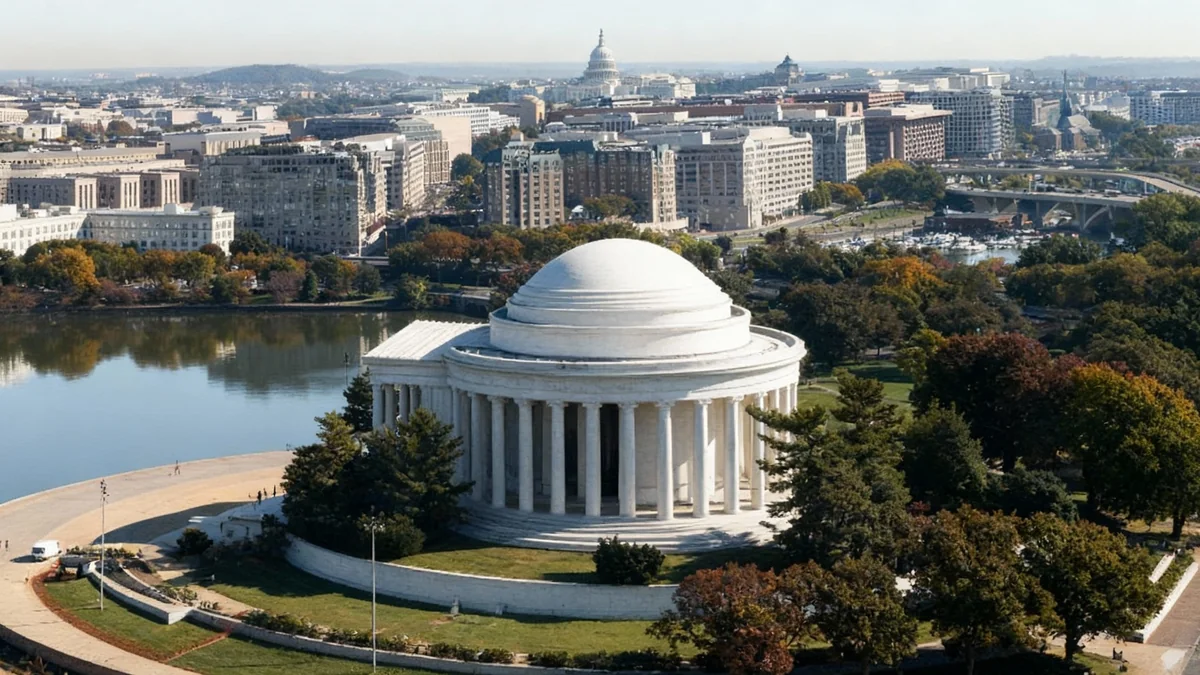Demolition work has begun on a section of the White House East Wing, making way for a planned new ballroom. This development follows a direct order from President Trump, who announced the project earlier this summer. The move has generated considerable discussion among architects, preservationists, and legal experts regarding historical preservation and constitutional authority.
Key Takeaways
- Demolition of part of the East Wing is underway for a new White House ballroom.
- The project is estimated to cost $200 million and cover 90,000 square feet.
- President Trump stated the East Wing is being modernized, not torn down, despite photographic evidence.
- Legal questions have been raised regarding the President's authority and funding for the construction.
- Architectural and preservation groups expressed strong concerns about the project's impact on a national symbol.
Construction Underway Despite Earlier Denials
Photographs circulating this week confirm that excavators are actively tearing down a portion of the East Wing. This contradicts earlier statements from White House Press Secretary Karoline Leavitt, who previously assured the public that "nothing will be torn down" to build the new structure. President Trump posted on Truth Social on October 20, announcing the groundbreaking for what he described as the "new, big, beautiful White House Ballroom."
He further added, "Completely separate from the White House itself, the East Wing is being fully modernized as part of this process, and will be more beautiful than ever when it is complete!" The new ballroom project is slated to be a substantial undertaking, with an estimated cost of $200 million and a sprawling footprint of 90,000 square feet.
Project Details
- Estimated Cost: $200 million
- Size: 90,000 square feet
- Design Firm: McCrery Architects
- Construction Company: Clark Construction
- Engineering Support: AECOM
Legal and Preservation Concerns Emerge
The legality and implications of the demolition have quickly become a focal point. Attorney Ben Meiselas has publicly suggested that anyone with the authority should "seek an injunction to block this construction," arguing that President Trump's actions could be "in violation of Article 1 of the Constitution." This legal challenge stems from questions surrounding executive power in altering federal property.
Adding to the complexity, some observers point out that the White House is exempt from certain provisions of the National Historic Preservation Act of 1966. Specifically, Section 106, which typically mandates federal agencies to assess the impact of projects on historic properties, does not apply to the White House. The ongoing government shutdown further complicates matters, as it currently blocks conventional channels for securing budget authorization for such large-scale projects.
"If I ran for President in 2028, I'd run on taking a bulldozer to Trump's ballroom, an utter desecration of the peoples' house."
Historical Context
The Committee for the Preservation of the White House, established in 1964, serves as an advisory group dedicated to the preservation of the White House. This committee typically plays a role in guiding decisions related to modifications of the historic property.
Funding and Architectural Opposition
The funding mechanism for the ballroom has also drawn scrutiny. President Trump previously indicated that the project would be financed by "generous Patriots, Great American Companies, and, yours truly." Earlier this month, a fundraising dinner was held in the East Room, attended by more than three dozen executives from major corporations including Amazon, Apple, Google, Microsoft, and Lockheed Martin. This event aimed to gather financial support for the ballroom's construction.
The American Institute of Architects (AIA) issued formal recommendations to the Committee for the Preservation of the White House in August regarding the ballroom proposal. The AIA described the project as "more than an addition to a building." They emphasized it is a "transformation to an irreplaceable symbol of our democracy—guided by a process that is preservation-first, performance-driven, and accountable to the public." The AIA also provided five key recommendations derived from its Framework for Design Excellence to guide the project's execution, but these recommendations appear to have been disregarded.
Public and Political Reaction
The images of demolition have ignited strong reactions. Former Republican Congressman Joe Walsh called the ballroom proposal an "utter desecration." He even suggested a future presidential campaign platform would include dismantling the new structure. These comments highlight the deep divisions surrounding the project's appropriateness and impact on a national landmark.
The architectural designs for the new ballroom indicate an elaborate interior. Plans feature gilded elements and Venetian windows, aiming for a grand aesthetic. However, the swiftness of the project, from its announcement in August to the start of demolition in October, has surprised many in the architectural and preservation communities, who expected a more deliberative process.
The Future of the White House East Wing
As construction progresses, the public debate continues. The White House website's "Visit" page still contains a message about the construction, stating the "White House Ballroom will be substantially separated from the main building of the White House, but at the same time, it’s theme and architectural heritage will be almost identical." This statement aims to reassure the public about the project's integration with the existing architecture.
However, the visual evidence of demolition raises questions about the definition of "modernization" versus significant alteration of a historic building. The controversy underscores the delicate balance between presidential prerogatives, historical preservation, and public accountability when it comes to iconic national structures.




